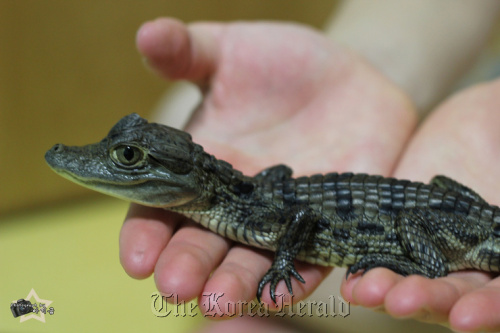His room that was first shared with a single snake is now more like a jungle with 121 animals of 21 species. Stacks of cages keep a California King Snake, Snow Corn Snake, Columbia Red Tail Boa, Asian forest scorpion, Bumble bee toad, Indian ornamental spider and more.
Raising them is not easy.
“The reptiles do not recognize their owners ... they still bite me. If you want pets of this kind, you need to put in more than a month to just enduring the hardship and should be able to give up on affection and bonding,” he said.
Disposing of the waste is also a tough job, but Jang said his pets have changed his life.
“I come home and check whether my room is clean enough to provide the animals with the best possible environment. I started studying English to read foreign books on bringing up such animals. Most of all, I have become a better person in light of caring for others,” he said.
Jang and his friends who share the same hobby hold exhibitions occasionally so more people can learn about rare pets. Some of them are held for free and their tour displays are always successful as more and more people want to see uncommon creatures outside of the zoo.
“At first, people would be scared because of their looks but slowly fall for them,” he said, smiling. “That’s something great about these pets.”
Like Jang, more people are opening their eyes to another “dimension” of keeping a pet. According to a report by the Korea Customs Service, the number of imported exotic animals has increased steadily over the past few years. In the first half of 2010, the number of iguanas brought here was 5,500, up 27.9 percent from 4,300 the previous year. A total of 1,131 chameleons and 2,754 lizards were imported during the same period, registering a remarkable 87.1 percent rise, according to the authorities. There are at least five online communities with thousands of members who are interested in keeping such rare and exotic animals. From reptiles to insects, mammals and crustaceans, all kinds of creatures are now kept at home. They share information about food, good veterinarians, habits they spot and everything else related to owning an exotic pet. They hold meetings about twice a year to see each other’s pets and sometimes hold large-scale events to familiarize the public with their favorite animals.
Still, compared to the estimated 2 million cats and dogs at homes across the country, their number is small, but interest in rare creatures is increasing.
Pet shops and veterinarians are facing growing demand for their services for people’s rather exotic, special “companions.”
“At first, we were a little worried,” said Kim Se-won, a veterinarian running a clinic in southern Seoul, as he recalled his first encounter with a snake. Though he knew that the animal wouldn’t do any harm, he did not know what to do.
“It is still a rare case, but I see more people consulting me about exotic pets,” he said.
Lee Hyung-suk, professor of the Department of Companion Animal Science at Woo Song College, said more people are looking for something different so that they look to raise reptiles and other rare species.
“These days many people live in apartments, which means that it has become No. 1 priority not to bother others with noise when it comes to raising pets. And more people are seeking for originality even in pets,” he said.
He said the public attitude toward pets has also become more understanding, allowing people with extraordinary animal companions to “come out” into the light and declare their uncommon hobbies.
But there is a dark side to raising exotic pets.
Lee Dong-hee, a 40-year-old man who raises 20 pets including a parrotlet, a Boa constrictor, tarantula, dog and cat, said lack of information about these creatures could end in tragedy.
“Quite a few people just buy exotic pets just to show off. These animals have special backgrounds so they need special care in everything ― temperature, water, food, secretions and the like. Without careful consideration, they could easily die,” he said.
Saying that he and his family’s life revolves around his pets, Lee stressed the need to study and learn to take responsibility as a pet owner.
“These animals live under extreme stress when they are raised as pets. High stress could cause malformation, and then they are abandoned. Don’t take these animals as an object of curiosity,” he said.
Lee of Woo Song College noted possible health risks in having reptiles and exotic animals as animal companions.
“Many of the diseases they catch could infect humans, especially children. People should take all possibilities and risks into consideration before making a decision on adoption of the animals. Keeping a pet is a serious matter,” he said.
By Bae Ji-sook (
baejisook@heraldcorp.com)








